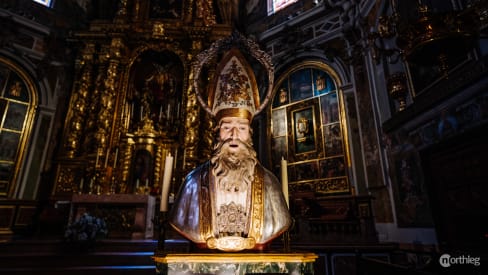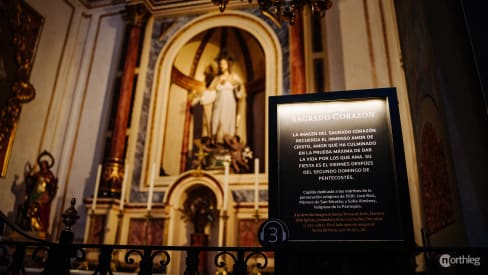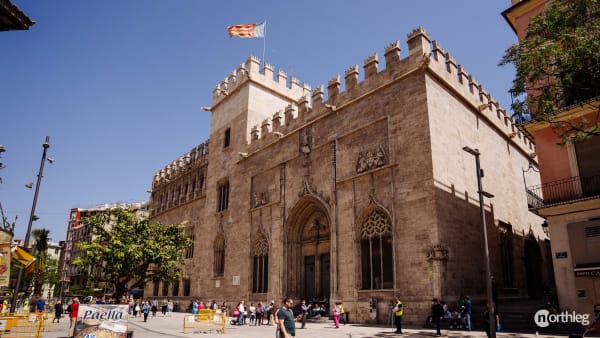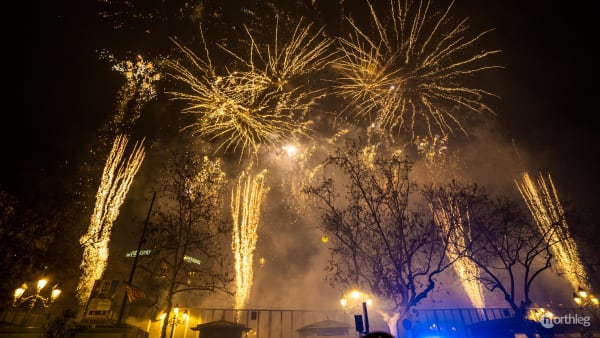Curiosities
Curiosities
In this section you can find some curiosities and stories linked to San Nicolás Church and its patrons. For example, you can read some anecdotes about the restoration of the frescoes that embellish the ceiling of the Church or learn some (rather grim) stories about Saint Nicholas and Saint Peter.
The restoration
In 2013, the largest pictorial ensemble in Spain was restored in an architectural, ornamental and pictorial intervention that lasted three years and involved hundreds of artists.
This Baroque work of art, designed by Antonio Palomino and executed by his disciple Dionís Vidal in 1700, covers about 2,000 square metres (over 21,500 square feet) on the ceilings of the Saint Nicholas Church. To bring it back to its original splendour, a multidisciplinary team from the Polytechnic University of Valencia was put together.

The team treated not only the frescoes, but also the chapels, facades, and glass windows present in the Church. For the restoration of what has been called the Sistine Chapel of Spain, an unprecedented workforce was mobilised.
The artists put in more than 41,000 hours of work, used 6,000 sheets of Japanese paper, 10,000 litres of distilled water (more than 2,600 gallons), 500 brushes, and 100 kg (220 pounds) of cotton wool.
A multitude of advanced techniques were used in the project. To re-establish the colours and contrast of the paintings, for example, laser beams and laboratory-trained bacteria were used.
On site, the bacteria ate away at specific materials without damaging the paintwork. Thanks to this excellent work we can now enjoy the spectacular view inside Saint Nicholas Church.
Saint Nicholas’ many names
Although the church officially maintains the title of Saint Nicholas of Bari and Saint Peter Martyr (San Nicolás de Bari y San Pedro Mártir, in Spanish), it is popularly known simply as Saint Nicholas Church.
Saint Nicholas himself is known either as Saint Nicholas of Myra (the place of his death and where he practised his office, in Turkey) or Saint Nicholas of Bari (the place where his remains were transferred after his death, in Italy).
He is mostly known as the latter in the West. Because of the numerous miracles attributed to him he is also known as Nicholas the Wonderworker.

In his life, he had been a bishop. After his death, in 345, he famously became the inspiration for Santa Claus. The change of names comes from a linguistic shift: from the German Sankt Niklaus and then Dutch Sinterklaas later came Santa Claus.
Saint Nicholas and the children’s meat
There is a macabre story told about one of the many miracles that Saint Nicholas supposedly performed.
Although the story is apocryphal (meaning not accepted in the Roman Christian canon), it is alluded to on one of the exterior arches of the Church and on the frescoes inside.

According to the story, Saint Nicholas was travelling and stopped at a tavern for supper. The innkeeper (a precursor to Sweeney Todd, we might think) served him a plate of meat. When the Saint went to bless the dish he realised that the meat he had been served was human flesh.
In the tavern keeper’s cellars, the remains of three teenagers were found. It is added that the three miraculously rose from the dead at the Saint’s command. For this reason, you might find Saint Nicholas at times depicted with a cauldron from which the three resurrected children emerge.
Saint Peter’s knife
The lesser-known of the two saint patrons of the Church is Saint Peter Martyr, also known as Saint Peter of Verona. He was born and died in northern Italy, he was a Dominican friar and priest, not to be confused with Saint Peter the Apostle.
Saint Peter Martyr was murdered by a heretical conspiracy in 1252 by a blow to the head with a knife (or axe, depending on the version you’re reading).

It is then told that Peter rose to his knees, and recited the first article of the Apostles’ Creed (a statement of faith). Allegedly, he then dipped his fingers in his own blood and wrote on the ground Credo in Deum (the first words of the Apostles’ Creed, meaning I believe in God). In somewhat gruesome taste, he is often depicted with said knife lodged in his head.















